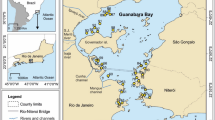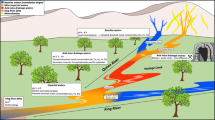Abstract
This study focuses on the distribution of selected trace metals, 137Cs and 210Pb, in floodplain deposits of the lowland Warta River (southern Poland) downstream of Częstochowa, a large city with an iron smelter. The depth profiles of trace metal (Zn, Pb, Cu, Ni, Cd and Mn), 210Pb and 137Cs contents in floodplain sediments were used to derive deposition rates on the floodplain for the twentieth century. The applicability of particular chronometric tools is considered within the context of their mutual relationships and confirmed by the consistency of the results. Deposition rate estimates for the past 50 years based on the vertical patterns of trace metal concentrations, which were correlated with particular events in the development of the smelter, range from 0.4 cm·year−1 in profiles situated in backswamps far from the channel to over 1.1 cm·year−1 in profiles of the natural levee adjacent to the river. Deposition rates based on 210Pb inventories in the profiles range from 0.08 to 0.66 g·cm−2·year−1, which corresponds to linear sedimentation rates of 0.10 to 0.91 cm·year−1, respectively. Dating of characteristic levels associated with peak fallout of 137Cs gives sediment accretion rates resembling those obtained from trace metals and 210Pb. The period of the highest sediment accumulation rate could be related to the highest loads of effluent from the iron smelter and city of Częstochowa, which were substantially reduced after the construction of effluent treatment plant.





Similar content being viewed by others
References
Aalto, R., Maurice-Bourgoin, L., Dunne, T., Montgomery, D. R., Nittrouer, C. A., & Guyot, J. L. (2003). Episodic sediment accumulation on Amazonian flood plains influenced by El Nino/Southern Oscillation. Nature, 425, 493–497.
Bølviken, B., Bogen, J., Jartun, M., Langedal, M., Ottesen, R. T., & Volden, T. (2004). Overbank sediments: A natural bed blending sampling medium for large-scale geochemical mapping. Chemometrics and Intelligent Laboratory Systems, 74, 183–199.
Carter, J., Owens, P. N., Walling, D. E., & Leeks, G. J. L. (2003). Fingerprinting suspended sediment sources in a large urban river system. Science of the Total Environment, 314, 513–534.
Chau, N. D., Niewodniczański, J., Dorda, J., Ochoński, A., Chruściel, E., & Tomza, I. (1997). Determination of radium isotopes in mine waters through alpha and beta-activities measured by liquid scintillation spectrometry. Journal of Radioanalytical and Nuclear Chemistry, 222(1–2), 69–74.
Ciszewski, D. (2003). Heavy metals in vertical profiles of the middle Odra River overbank sediments: Evidence for pollution changes. Water, Air and Soil Pollution, 143(1–4), 81–98.
Ciszewski, D., Czajka, A., & Błażej, S. (2008). Rapid migration of heavy metals and 137Cs in alluvial sediments, Upper Odra River valley, Poland. Environmental Geology, 55, 1577–1586.
Claret, C., Boulton, A. J., Dole-Olivier, M. J., & Marmonier, P. (2001). Functional processes versus state variables: Interstitial organic matter pathways in floodplain habitats. Journal of Fisheries and Aquatic Sciences, 58(8), 1594–1602.
De Vos, W., Ebbing, J., Hindel, R., Schalich, J., Swennen, R., & VanKeer, I. (1996). Geochemical mapping based on overbank sediments in the heavily industrialised border area of Belgium, Germany and The Netherlands. Journal of Geochemical Exploration, 56(2), 91–104.
Forusiak, K., Malarski, T., Bala, J., & Mandrysz, J. (2003). Huta Częstochowa 1896–2002 (pp. 1–544). Częstochowa: Jurapress.
Greeman, D. J., Rose, A. W., Washington, J. W., Dobos, R. R., & Ciokosz, E. J. (1999). Geochemistry of radium in soils of the Eastern United States. Applied Geochemistry, 14, 365–385.
Hamers, T., van den Berg, J. H. J., van Gestel, C. A. M., van Schooten, F. J., & Murk, A. J. (2006). Risk assessment of metals and organic pollutants for herbivorous and carnivorous small mammal food chains in a polluted floodplain (Biesbosch, The Netherlands). Environmental Pollution, 144, 581–595.
He, Q., & Walling, D. E. (1996). Use of fallout Pb-210 measurements to investigate longer-term rates and patterns of overbank sediment deposition on the floodplains of lowland rivers. Earth Surface Processes and Landforms, 21, 141–154.
Hudson-Edwards, K. A., Macklin, M. G., Curtis, C. D., & Vaughan, D. J. (1998). Chemical remobilization of contaminant metals within floodplain sediments in an incising river system: implications for dating and chemostratigraphy. Earth Surface Processes and Landforms, 23, 671–684.
Koide, M., Souter, A., & Golberg, E. D. (1972). Marine geochronology with 210Pb. Earth and Planetary Science Letters, 14, 442–446.
Korobova, E., Linnik, V., & Chizhikova, N. (2008). The history of the Chernobyl Cs-137 contamination of the flood plain soils and its relation to physical and chemical properties of the soil horizons (a case study). Journal Geochemical Exploration, 96(2–3), 236–255.
Lair, G. J., Graf, M., Zehetner, F., & Gerzabek, M. H. (2008). Distribution of cadmium among geochemical fractions in floodplain soils of progressing development. Environmental Pollution, 156(1), 207–214.
Lecce, S. A., & Pavlowsky, R. T. (2001). Use of mining-contaminated sediment tracers to investigate the timing and rates of historical flood plain sedimentation. Geomorphology, 38(1–2), 85–108.
Lis, J., & Pasieczna, A. (1996). Geochemical atlas of Poland 1:250, 000. Warszawa: PIG.
Livens, F. R., & Baxter, M. S. (1988). Particle size and radionuclide levels in some west Cumbria soils. Science of the Total Environment, 70, 1–17.
Lowrance, R., Todd, R., Fail, J., Hendrickson, O., Leonard, R., & Asmussen, L. (1984). Riparian forests as nutrient filters in agricultural watersheds. BioScience, 34, 374–377.
Macklin, M., Ridgway, J., Passmore, D. G., & Rumsby, B. T. (1994). The use of overbank sediment for geochemical mapping and contamination assessment: Results from selected English and Welsh floodplains. Applied Geochemistry, 9, 689–700.
Matschullat, J., Ellminger, F., Agdemir, N., Cramer, S., Liessmann, W., & Niehoff, N. (1997). Overbank sediment profiles—Evidence of early mining and smelting activities in the Harz mountains, Germany. Applied Geochemistry, 12(1), 105–114.
Middelkoop, H. (2002). Reconstructing floodplain sedimentation rates from trace metal profiles by inverse modeling. Hydrological Processes, 16, 47–64.
Moore, H. E., Martell, E. A., & Poet, S. E. (1976). Sources of polonium-210 in the atmosphere. Environnmental Science and Technology, 10, 586–591.
Nicholas, A. P., & Walling, D. E. (1997). Investigating spatial patterns of medium-term overbank sedimentation on floodplains: A combined numerical modeling and radiocesium approach. Geomorphology, 19, 133–150.
Ottesen, R. T., Bogen, J., Bölviken, B., & Volden, T. (1989). Overbank sediment: A representative sample medium for regional geochemical mapping. Journal of Geochemical Exploration, 9, 689–700.
Owczarek, P. (2002). The differentation of the conditions of alluvial sedimentation in the Warta gorge through the Cracow Upland, Poland. Quaestiones Geographicae, 22, 59–66.
Paulson, A. J. (1997). The transport and fate of Fe, Mn, Cu, Zn, Cd, pH and SO4 in groundwater plume and in downstream surface waters in the Cour d`Alene mining district, Idaho, USA. Applied Geochemistry, 12, 447–464.
Pizzuto, J. E. (1987). Sediment diffusion during overbank flows. Sedimentology, 34, 301–317.
Ritchie, J. C., & McHenry, J. R. (1990). Application of radioactive fallout ceasium-137 for measuring soil erosion and sediment accumulation rates and patterns: A review. Journal of Environmental Quality, 19, 215–233.
Ritchie, J. C., & McCarty, G. W. (2003). 137Cesium and soil carbon in a small agricultural watershed. Soil & Tillage Research, 69, 45–51.
Smith, K. A., & Paterson, J. E. (1990). Manganese and cobalt. In B. J. Alloway (Ed.), Heavy metals in soils (pp. 7–28). New York: Wiley.
Swennen, R., & Van Der Sluys, J. (1998). Zn, Pb, Cu and As distribution patterns in overbank and medium-order stream sediment samples: Their use in exploration and environmental geochemistry. Journal of Geochemical Exploration, 65, 27–45.
Swennen, R., Van Keer, I., & De Vos, W. (1994). Heavy metal contamination in overbank sediments of the Geul River (east Belgium): Its relation to former Pb–Zn mining activities. Environmental Geology, 24, 12–21.
Taylor, M. P. (1996). The variability of heavy metals in floodplain sediments: A case study from mid-Wales. Catena, 28, 71–87.
Van den Berg, G. A., Loch, J. P. G., & Winkels, H. J. (1998). Effect of fluctuating hydrological conditions on the mobility of heavy metals in soils of freshwater estuary in The Netherlands. Water Air and Soil Pollution, 102, 377–388.
Venterink, H. O., Vermaat, J. E., Pronk, M., Wiegman, F., van der Lee, G. E. M., van den Hoorn, M. W., et al. (2006). Importance of sediment deposition and denitrification for nutrient retention in floodplain wetlands. Applied Vegetation Science, 9, 163–174.
Walling, D. E., & He, Q. (1997). Use of 137Cs fallout in investigations of overbank sediment deposition on river floodplains. Catena, 29, 263–282.
Walling, D. E., & He, Q. (1999). Changing rates of overbank sedimentation on the floodplains of British rivers during the past 100 years. In A. G. Brown & T. A. Quine (Eds.), Fluvial processes and environmental change (pp. 207–222). Chichester: Wiley.
Walling, D. E., He, Q., & Nicholas, A. P. (1996). Floodplains as suspended sediment sinks. In M. G. Anderson, D. E. Walling & P. D. Bates (Eds.), Floodplain processes (pp. 399–440). Chichester: Wiley.
Walling, D. E., Owens, P. N., Carter, J., Leeks, G. J. L., Lewis, S., Meharg, A. A., et al. (2003). Storage of sediment-associated nutrients and contaminants in river channel floodplain systems. Applied Geochemistry, 18, 195–220.
Acknowledgements
This research project was financed by the State Committee for Scientific Research from the budgetary funds in the years 2005–2006 (2 P04G 012 28).
Author information
Authors and Affiliations
Corresponding author
Rights and permissions
About this article
Cite this article
Łokas, E., Wachniew, P., Ciszewski, D. et al. Simultaneous Use of Trace Metals, 210Pb and 137Cs in Floodplain Sediments of a Lowland River as Indicators of Anthropogenic Impacts. Water Air Soil Pollut 207, 57–71 (2010). https://doi.org/10.1007/s11270-009-0119-4
Received:
Accepted:
Published:
Issue Date:
DOI: https://doi.org/10.1007/s11270-009-0119-4




